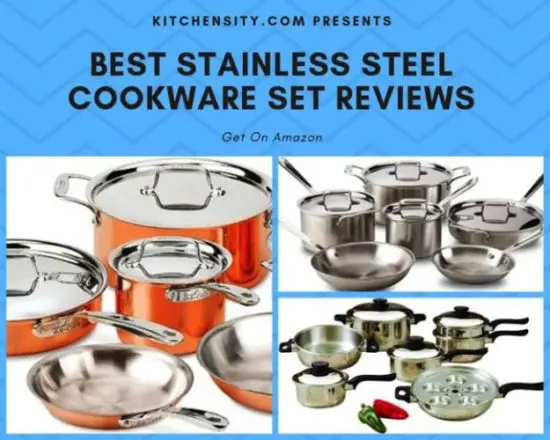No, stainless steel cookware is not inherently nonstick. Unlike nonstick cookware, which has a coating that prevents food from sticking, stainless steel cookware relies on its natural properties for cooking. While stainless steel is known for its durability and resistance to rust and corrosion, it can be prone to food sticking if not properly seasoned or if the cooking temperature is not controlled.

Table of Contents
- 1 Does Food Stick To Stainless Steel Cookware?
- 2 How To Make Stainless Steel Nonstick?
- 3 Are Stainless Steel Saucepans Nonstick?
- 4 Comparative Analysis With Nonstick Cookware.
- 5 Tips For Avoiding Scratches On Stainless Steel
- 6 Final Thoughts: Is Stainless Steel Cookware Nonstick?
- 7 FAQs (People May Also Ask).
- 7.1 Is Cuisinart Stainless Steel Cookware Nonstick?
- 7.2 Is Viking Stainless Steel Cookware Nonstick?
- 7.3 Is Stainless Steel Cookware Suitable For All Types Of Stoves?
- 7.4 Can I Use Metal Utensils With Stainless Steel Cookware?
- 7.5 How Do I Prevent Food From Sticking To Stainless Steel Pans?
- 7.6 Are There Health Concerns Associated With Stainless Steel Cookware?
- 7.7 Can I Put Stainless Steel Cookware In The Dishwasher?
Properties of Stainless Steel Cookware.
Stainless steel is a popular choice for cookware due to its many beneficial properties:
- Stainless steel is very durable and resistant to scratches, dents, and corrosion, making it ideal for long-term use in the kitchen.
- While not as good as materials like aluminum or copper, stainless steel still conducts heat fairly well, allowing for even cooking.
- Stainless steel is non-reactive with acidic foods, so it won’t impart any metallic taste or react with the food.
- Stainless steel is generally easy to clean and is dishwasher safe.
- It has a modern and sleek appearance that many people find attractive in their kitchen.
- Stainless steel cookware can be used on different types of stovetops, including gas, electric, and induction.
- With proper care, stainless steel cookware can last a long time, making it a good investment for your kitchen.
Also Read – Is Stainless Steel Safe For Cooking?
Why Stainless Steel Is Not Nonstick?
Stainless steel is not naturally nonstick because it lacks the slick surface that prevents food from sticking. Nonstick cookware, on the other hand, has a coating (such as PTFE or ceramic) that provides a smooth, nonporous surface which reduces friction and prevents food from adhering to the cookware. Stainless steel’s surface is relatively rough compared to nonstick coatings, making it more prone to food sticking.
Also, stainless steel does not have the same heat retention properties as materials like cast iron, which can further contribute to food sticking if the pan is not preheated properly.
You May Also Like: How To Season Stainless Steel Pots And Pans?
Does Food Stick To Stainless Steel Cookware?
Yes, food can stick to stainless steel cookware, especially if not used correctly. Unlike nonstick pans, stainless steel doesn’t have a naturally nonstick surface. However, with proper techniques, you can minimize sticking and enjoy the benefits of cooking with stainless steel.
One common reason for food sticking to stainless steel is not preheating the pan adequately. Preheating helps create a thin layer of hot oil on the surface, forming a barrier between the food and the pan. Without this, food is more likely to adhere to the metal.
Using an insufficient amount of oil or butter is another culprit. Stainless steel requires a bit more lubrication than nonstick surfaces. Adding an ample amount of oil or using butter can create a nonstick effect and enhance the flavor of your dish.
Patience is key when cooking with stainless steel. Let the food develop a sear or crust before moving or flipping it. This crust acts as a natural barrier, reducing the chances of sticking.
Properly maintaining and seasoning your stainless steel cookware can also contribute to its nonstick properties over time. Regularly cleaning and seasoning the pan with oil can create a protective layer, improving its performance.
Also Read – Stainless Steel vs Nonstick vs Ceramic Cookware Set
How To Make Stainless Steel Nonstick?
Making stainless steel nonstick involves employing a few techniques to create a smoother cooking surface and reduce the chances of food sticking. While stainless steel doesn’t naturally possess nonstick properties like coated pans, following these steps can significantly improve its performance.
- Ensure the pan is thoroughly preheated before adding any ingredients. A hot pan helps create a temporary nonstick effect by forming a thin layer of hot oil on the surface.
- Stainless steel requires more lubrication than nonstick surfaces. Add a sufficient amount of oil or use butter to coat the pan evenly. This helps in creating a barrier between the food and the stainless steel.
- Patience is crucial when cooking with stainless steel. Let the food develop a sear or crust before moving or flipping it. This crust acts as a natural nonstick barrier.
- Regularly season your stainless steel cookware to improve its nonstick properties. To do this, coat the pan with a high-smoke-point oil (like vegetable or grapeseed oil) and heat it until it starts smoking. Wipe off the excess oil and let the pan cool. This process creates a protective layer on the surface.
- Overcrowding the pan can lead to uneven cooking and increase the chances of food sticking. Give each piece of food enough space to ensure proper searing.
- Adjust your cooking techniques to suit stainless steel. For example, let meats come to room temperature before cooking, as adding cold food to a hot pan can lead to sticking.
- Stainless steel is a good conductor of heat, so you may be able to cook at a lower heat setting than you’re used to with other types of cookware.
- Opt for utensils made of wood, silicone, or other non-metal materials to avoid scratching the pan’s surface. Even though stainless steel is durable, scratches can compromise its nonstick abilities.
- Clean the pan promptly after use to prevent food residue from building up. Use a gentle abrasive, such as baking soda, if needed. Avoid harsh scrubbers that can scratch the surface.
Also Read – Best Stainless Steel Cookware Under $100
Are Stainless Steel Saucepans Nonstick?
Stainless steel saucepans are not inherently nonstick. They lack a coating that provides a slick surface to prevent food from sticking. However, you can use techniques such as preheating the pan, using oil or fat, and using lower heat settings to reduce sticking in stainless steel saucepans. Also, regular use and seasoning of stainless steel cookware can help develop a more nonstick surface over time.
According to Chef Gordon Ramsay “Stainless steel cookware provides excellent heat conduction, but it’s not nonstick. Using lower cooking temperatures and adding oil can help create a more nonstick surface.”
Also Read – Carbon Steel Vs Stainless Steel Vs Cast Iron Pans
Comparative Analysis With Nonstick Cookware.
| Aspect | Stainless Steel Cookware | Nonstick Cookware |
| Cooking Performance | Excellent heat conductivity; suitable for searing and browning. | Ideal for low-fat cooking; and best for delicate items like eggs and pancakes. |
| Durability | Highly durable; resistant to scratches, dents, and corrosion. | Susceptible to scratches; coating may degrade over time. |
| Versatility | Versatile for various cooking methods, including stove-to-oven transitions. | Limited to stovetop use; avoids high oven temperatures to preserve coating. |
| Maintenance | Requires more effort for cleaning; resilient against abrasive tools. | Easy to clean; requires gentle tools to preserve the coating. |
| Longevity | Long-lasting with proper care; minimal degradation over time. | Lifespan depends on coating quality; may need replacement after a few years. |
| Health Considerations | Generally considered safe for cooking; no concerns about harmful substances. | Some concerns about chemical release at high temperatures; high-quality coatings are PFOA-free. |
| Cost | Initial investment is higher; long-term value is due to durability. | Generally more affordable; replacement costs may add up over time. |
Also Read – What Is Waterless Cookware?
Tips For Avoiding Scratches On Stainless Steel
Avoiding scratches on stainless steel cookware is essential to maintain its appearance and functionality. Here are some tips to help you keep your stainless steel pots and pans in top condition.
- Use non-abrasive cleaners.
- Avoid using metal utensils.
- Use gentle cleaning tools like soft sponges.
- Avoid harsh scrubbing.
- Dry with a soft cloth to prevent water spots.
- Store stainless steel items separately to avoid scratching.
- Use plastic or wooden utensils for cooking.
- Avoid cutting directly on stainless steel surfaces.
- Clean with mild soap and water.
- Use stainless steel cleaner and polish for extra protection.
Also Read – Ultimate Guide For Buying Stainless Steel Cookware
Final Thoughts: Is Stainless Steel Cookware Nonstick?
So, is stainless steel cookware nonstick? The answer is no, not exactly. Stainless steel brings different strengths to the kitchen. It’s tough, lasts a long time, and heats up evenly, but it doesn’t have that slick nonstick magic.
But here’s the scoop: don’t let that stop you! With a few tricks like preheating, a bit of oil, and some patience, you can make stainless steel cookware work wonders. It might not be as easy as nonstick, but it’s like the reliable friend in your kitchen – sturdy and versatile.
Choosing between stainless steel and nonstick? It depends on what you’re after. If you want something tough and ready for action, go for stainless steel. But if you’re all about quick and easy, non-stick might be your kitchen superhero.
Also Read – Best Stainless Steel Cookware Without Aluminum
FAQs (People May Also Ask).
-
Is Cuisinart Stainless Steel Cookware Nonstick?
No, Cuisinart stainless steel cookware is not nonstick by default. It relies on the properties of stainless steel for cooking and may require oiling and preheating to minimize sticking.
-
Is Viking Stainless Steel Cookware Nonstick?
Similar to Cuisinart, Viking stainless steel cookware is not nonstick. It is designed for durability and even heating but may need proper preheating and the use of oil to prevent food from sticking.
-
Is Stainless Steel Cookware Suitable For All Types Of Stoves?
Stainless steel cookware is compatible with most stovetops, including gas, electric, and induction.
-
Can I Use Metal Utensils With Stainless Steel Cookware?
Yes, stainless steel is durable enough to withstand the use of metal utensils. However, using wooden or silicone utensils can help preserve the cookware’s appearance.
-
How Do I Prevent Food From Sticking To Stainless Steel Pans?
Preheat the pan, use adequate oil or butter, and allow the food to sear before attempting to flip or move it.
-
Are There Health Concerns Associated With Stainless Steel Cookware?
Stainless steel is generally considered safe for cooking. However, avoid using cookware with scratches or visible damage, as this can affect its safety.
-
Can I Put Stainless Steel Cookware In The Dishwasher?
While many stainless steel cookware pieces are dishwasher safe, hand washing is recommended to maintain appearance and performance.
Katrina Smith is a seasoned expert with over 25 years of experience in all things related to cooking and the kitchen. As an avid cook and kitchen enthusiast, she is passionate about sharing her knowledge and expertise on cookware, kitchen appliances, kitchen tips, and kitchen staples.
Through her articles and reviews, Katrina aims to inspire and help others improve their cooking skills, experiment with different ingredients, and invest in quality cookware and appliances.







Great article! It clarified that stainless steel cookware is not inherently nonstick. This information was really helpful for me, thanks!
Hi Ana, I’am glad you found the article helpful! If you have any more questions, feel free to ask.